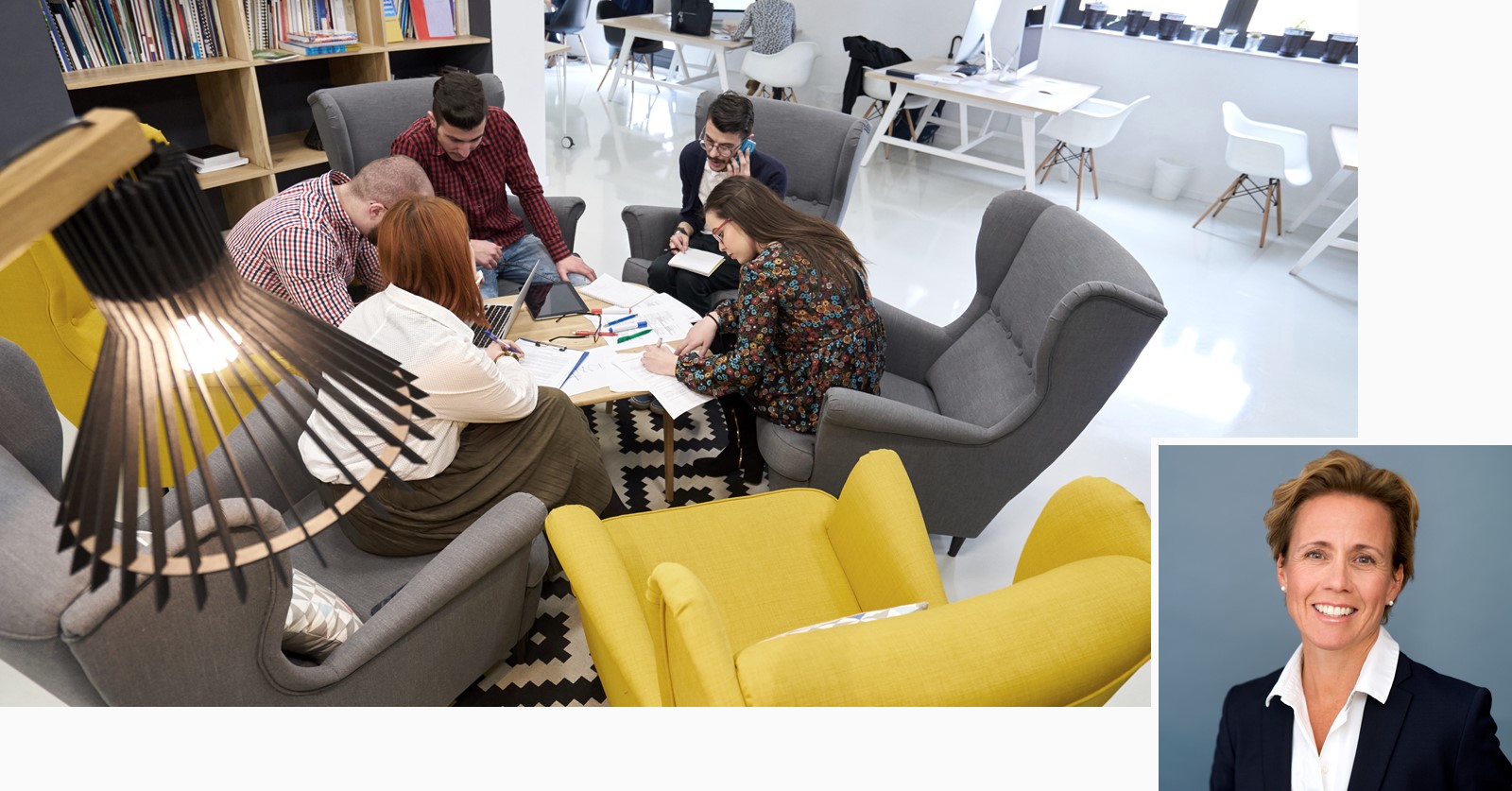All changes are hard but asking employees to give up their assigned desk and adopt an activity-based work (ABW) style can be especially challenging. Initial resistance is often rooted in discomfort with the unknown and other personal emotions, so it is important to mix education with empathy when working to separate fact from fear. CBRE’s Workplace experts have compiled a list of the five most common myths about ABW and how to address them.
Myth #1
We can achieve ABW without making changes to the physical environment.
Reality: Desk sharing as an occupancy strategy can technically be implemented without design intervention, and historically this is how “hoteling” has been applied. An occupier can take an existing bank of workstations and/or offices and name them as “hotel” spaces, but this will not yield the best results. To move from “hoteling” to true “activity-based working,” you may need to reconsider space allocations.
ABW works best in a well-balanced work ecosystem, with a healthy mix of open and enclosed spaces, spaces for collaboration, spaces for heads-down focus work, and spaces for community. If your office environment is deficient in any of these categories, you will see increased competition for desirable spaces and decreased office attendance.
Myth #2
Choosing ABW means that we need to convert our office to “open plan,” and we will lose all our private space.
Reality: The goal of ABW is to provide variety and choice to employees so that they can practice not only external mobility (movement between remote sites and the office), but also internal mobility (movement between different space types within the office). Thus, moving to an entirely “open plan” office would be counterproductive. However, there is no magic formula to determine how much open vs. enclosed space you will need—ratios will vary industry to industry, and client to client. For example, law firms may apply ABW with a ratio of 80% offices to 20% workstations to feel more enclosed, while a technology company may need 5% offices to 95% workstations to achieve an open feel. In all cases, it is recommended to supplement traditional office and workstation space types with alternative focus areas (e.g., phone booths, focus rooms, library areas) and enclosed collaboration spaces to control noise and add space diversity. Savvy occupiers will look to understand the workstyles of their employees and align them to the provided space types so that each employee can choose the right space for the right task throughout the day.
Myth #3
People won’t be able to find their colleagues if they need to ask a question or collaborate.
Reality: The anxiety of locating people and places can easily be alleviated in an unassigned seating environment via the implementation of neighbourhoods. A neighbourhood is a collection of space types assigned to a particular department or function. For example, Neighborhood A could be assigned to the Finance department. None of the analysts have a specific assigned seat, but they know that this collection of spaces is their home, and they will gravitate here whenever they are in the office to work with their team members. They also would know that Neighborhood B is assigned to the Sales team, and if they have a question they know where to go to find someone to help. Additionally, don’t underestimate the impact of effective communication habits. It’s easy and practical to send a “where are you working today?” message or coordinate with your team before arriving at the office.
Myth #4
We won’t have enough seats if all employees want to come to the office on the same day.
Reality: In the pre-COVID world, most companies never saw a day of full occupancy. Occupancy of 70% was typical, including sick days, vacations, business travel, and remote work arrangements, but even companies with strong face-time cultures averaged 85% occupancy.1 With remote work becoming more popular, CBRE expects that peak occupancy will decrease. A well-designed ABW strategy will include a buffer of seats to account for growth, seasonal spikes (e.g., interns and audits), and the ebbs and flows of day-to-day operating. However, ABW also requires a re-framing of what constitutes a seat. Although there may be fewer traditional seats (i.e., offices and workstations) than people to create the desk sharing ratio, there will also be seats in alternative focus areas, collaboration areas, and amenities. Exactly how many seats of each type a company will need to accommodate daily traffic will depend on the workstyles of its employees. Broadly speaking, the more collaborative employees are expected to be in the office, the fewer traditional seats need to be provided.
Myth #5
Employees will spread more germs and our company will see an increase in sick leave.
Reality: As COVID-19 has evolved, germs have understandably been a top concern of employees returning to the office, and it is important to acknowledge that ABW may not be appropriate as a near-term strategy given these extraordinary circumstances. Occupiers should continue to review data for each geographic location in their portfolio and make decisions based on local factors such as transmission rate, vaccination rate and treatment availability. However, when considering long-term strategies, there are ways to mitigate the spread of germs in an ABW environment and help employees feel that their health and safety is a priority. First, improving ventilation and air quality is a primary driver in preventing the spread of disease.2 This can be accomplished by implementing higher MERV-rated or HEPA filters, increasing the rate of Air Changes per Hour (ACH) and upgrading maintenance schedules. Second, spaces with high occupancy density have higher risks of pathogen inhalation.3 Reduce density by providing generous circulation pathways and spacing between open seats. Finally, the above interventions, combined with enhanced cleaning and disinfection protocols4, touchless office technologies and personal hygiene reminders,5 can reduce infection risk significantly while desk sharing.
Learn more?
Want to know more about Activity Based Working and creating a Workplace Strategy suited for your needs, contact our Nordic Workplace experts:
Norway: Anne Rein
Sweden: Mikael Alserud
Denmark: Jacob Hald
Finland: Jutta Sellin
1 CBRE Workplace Pre-COVID Badge Data Database, n=61
2 “Risk of sick leave associated with outdoor air supply rate, humidification, and occupant complaints”, D K Milton, P M Glencross, M D Walters, National Library of Medicine.
3 “Germs, ventilation, occupancy density and exposure duration: A thirteen setting pathogen inhalation comparison”, D.S. Walkinshaw, ResearchGate.
4 “Impact of a hygiene intervention on virus spread in an office building”, Elkana K. Kurgat, Jonathan D. Sexton, Fernanda Garavito, Adriana Reynolds, R. David Contreras, Charles P. Gerba, Rachel A. Leslie, Sarah L. Edmonds-Wilson, Kelly A. Reynolds, ScienceDirect.
5 “Show Me the Science - Why Wash Your Hands?”, Centers for Disease Control and Prevention.

